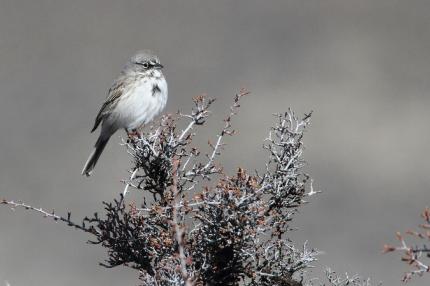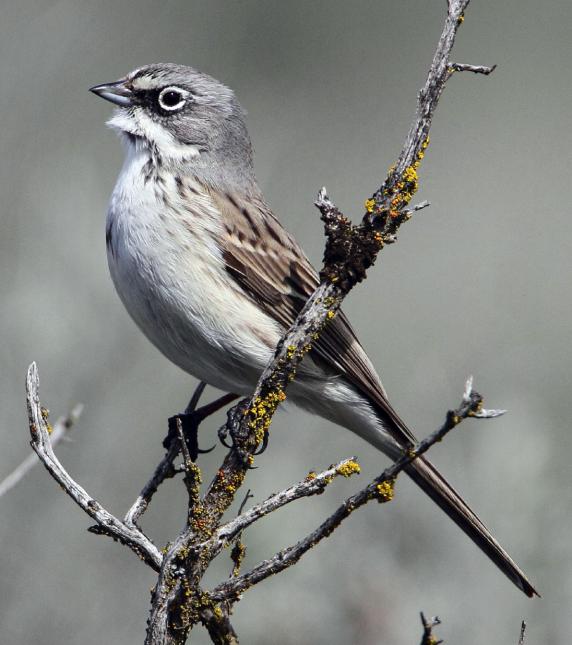Moderate-
High
The population of sagebrush sparrow in Washington is low. The sparrow is a species of concern because large expanses of big sagebrush (Artemisia tridentata), its preferred habitat, have been lost or degraded.
Description and Range
Physical description
The sagebrush sparrow is 5 to 6 inches in length. Males and females appear the same. They are generally brownish gray above, with their head being somewhat grayer and their back and wings being more brown. Sides and flanks are light, buffy gray, with dusky streaking. A white spot is in front of the eye, and there is a thin eye-ring. A horizontal white stripe is along the cheek. The underparts are mostly white, and there is a dark spot on the breast.
Ecology and life history
This is a sagebrush obligate species, typically associated with big sagebrush in eastern Washington. Sagebrush sparrows appear to be sensitive to patch size, and the probability they will use a site is higher in areas with large expanses of unconverted shrubsteppe, typically areas greater than 2,500 acres.

During the breeding season, this species forages on the ground for insects, spiders, small fruits, and seeds. During the non-breeding season, diet is similar but also includes succulent plant material.
Pairs generally arrive together on breeding grounds. Males sing atop sagebrush in defense of their territory. Nest building in or under big sagebrush begins in mid-March. After an incubation period of 10 to 16 days, the young usually leave the nest 9 to 10 days after hatching. Most females raise two broods per year.
Geographic range
The sagebrush sparrow prefers the sagebrush/bunchgrass shrubsteppe landscapes of the Columbia Basin and is an uncommon migrant and summer resident in the shrubsteppe of eastern Washington. This sparrow migrates to overwintering areas between central California and central Nevada, including as far south as northern Mexico. Population trends in the Great Basin and in individual states (Nevada, Utah) since 1966 are stable, as is the trend in Washington. However, the Washington trend is based on a small sample that may not be reliable. Declining trends have been reported in Idaho (moderate reliability) and Oregon (high reliability). There is no population estimate for Washington.
For a map of range-wide distribution and conservation status of this species, check out NatureServe Explorer.
Climate vulnerability
Sensitivity to climate change
Moderate-
High
Very limited information is available regarding sensitivity of sagebrush sparrows to climate change, particularly in Washington, and particularly due to recent separation from Bell's sparrow. However, as sagebrush obligates that require relatively intact and undisturbed sage for breeding, sagebrush sparrows are likely vulnerable to any climate changes that affect the extent, quality, and connectivity of sagebrush habitats. Increasing fire frequencies (due to climate change and perpetuated by invasive species, e.g., cheatgrass), warming temperatures, precipitation variability, and drought are likely to contribute to reductions in sagebrush habitat, negatively affecting this species. Sagebrush sparrows may also be physiologically sensitive to warming temperatures; they avoid nesting on hot, southwest aspects, and position nests to maintain airflow (which is hypothesized to ameliorate high temperatures during nesting periods).
Exposure to climate change
Moderate
- Increased invasive weeds
- Altered fire regimes
- Increased temperatures
- Changes in precipitation
- Drought
Conservation
Conservation Threats and Actions Needed
- Fish and wildlife habitat loss or degradation
- Threat: Habitat loss and fragmentation.
- Action Needed: Protect core areas of habitat; identify degraded habitat for restoration and establish connectivity between core areas.
- Agriculture and aquaculture side effects
- Threat: Habitat loss and fragmentation due to agricultural conversion.
- Action Needed: Protect and restore habitat; evaluate U.S. Department of Agriculture - Conservation Reserve Program (CRP) leases to provide functional habitat on private lands.
- Threat: Habitat degraded by intensive grazing.
- Action Needed: Outreach; develop and promote best management practices.
- Invasive and other problematic species
- Threat: Habitat degradation.
- Action Needed: Identify degraded habitat for restoration; control cheatgrass.
- Resource information collection needs
- Threat: Landscape-level habitat use.
- Action Needed: Conduct studies on use of sagebrush patches in landscapes of differing patchiness and connectivity.
See the Climate vulnerability section for information about threats posed by climate change to this species.
Resources
References
Martin, J. W. and B. A. Carlson 1998. Sage Sparrow (Amphispiza belli). Birds of North America 326: 1-20.
Vander Haegen, W. M. 2005. Sage Sparrow (Amphispiza belli). Pp 328 – 329 in T. R. Wahl, B. Tweit, and S. G. Mlodinow (eds.) Birds of Washington: Status and Distribution. Oregon State University Press, Corvallis, OR, USA. 436 pp.
